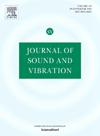Modal Complexity Factors as indexes for modal parameter identification in Operational Modal Analysis of coupled dynamic systems
IF 4.3
2区 工程技术
Q1 ACOUSTICS
引用次数: 0
Abstract
Vibration analysis seeks to extract the modal parameters of a mechanical system by means of experimental measurements. Natural frequencies, damping ratios and mode shapes are identified from the measurements data from experimental or operational modal analysis. Modal shapes can show real or complex values. The degree of complexity of a modal shape can be measured by the Modal Complexity Factors (MCF). Among others, modal complexity can be due to non-uniformly distributed damping. In complex mechanical systems like a robot, complex modes are expected due to its active and non distributed damping. In turn, in a metallic workpiece real modes are expected. In the robotic machining of thin workpieces, both the robot and the workpiece constitute a coupled dynamic system, operating within the same frequency range. This work proposes the use of MCFs as indexes to determine if each mode corresponds to the workpiece or the robot. Experimental results of an operational modal analysis show a lower mode complexity for the workpiece modes and a higher complexity for the robot frequencies. MCFs show a good performance in separating modes of such coupled systems due to the different damping nature of the robot and the workpiece.
求助全文
约1分钟内获得全文
求助全文
来源期刊

Journal of Sound and Vibration
工程技术-工程:机械
CiteScore
9.10
自引率
10.60%
发文量
551
审稿时长
69 days
期刊介绍:
The Journal of Sound and Vibration (JSV) is an independent journal devoted to the prompt publication of original papers, both theoretical and experimental, that provide new information on any aspect of sound or vibration. There is an emphasis on fundamental work that has potential for practical application.
JSV was founded and operates on the premise that the subject of sound and vibration requires a journal that publishes papers of a high technical standard across the various subdisciplines, thus facilitating awareness of techniques and discoveries in one area that may be applicable in others.
 求助内容:
求助内容: 应助结果提醒方式:
应助结果提醒方式:


